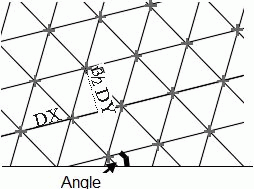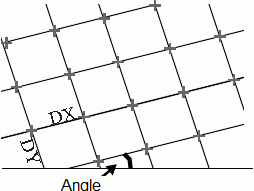The prerequisite for the node grid generator is a polygon boundary within which the node grid is to be generated. If the node grid generator is used globally, this is the closed contour boundary. When generating node grids in a regional area, the boundary polygon must be defined by the user.
Within the defined polygon, all contours are processed first before the node grid is generated (if this has not already been done during boundary node generation) and the mesh nodes required there are generated: on the point contours, on any defined well parameters refinement, and at the start, end and division points of the contour lines.
The nodes grid is then generated depending on the grid type (triangular grid or quadrilateral grid), distance parameters DX and DY and angle. No new nodes are generated in the vicinity of existing mesh nodes .

Triangular mesh based on a triangular grid
With the triangular grid, nodes are generated in such a way that in the case of DX=DY, the nodes can be meshed to form equilateral triangles with edge length DX that are rotated at the specified angle to the x-axis. In the distorted case (DX not equal to DY), the nodes are generated in such a way that isosceles triangles with base side length DX and height DY*sqrt(3)/2 are generated, with the specified angle with the x-axis.

Quadrangular mesh based on a quadrangular grid
With the quadrilateral grid, the nodes are generated in such a way that they can be meshed to form rectangles with edge lengths DX and DY that include the specified angle with the x-axis.
 Triangulation in SPRING
Triangulation in SPRING